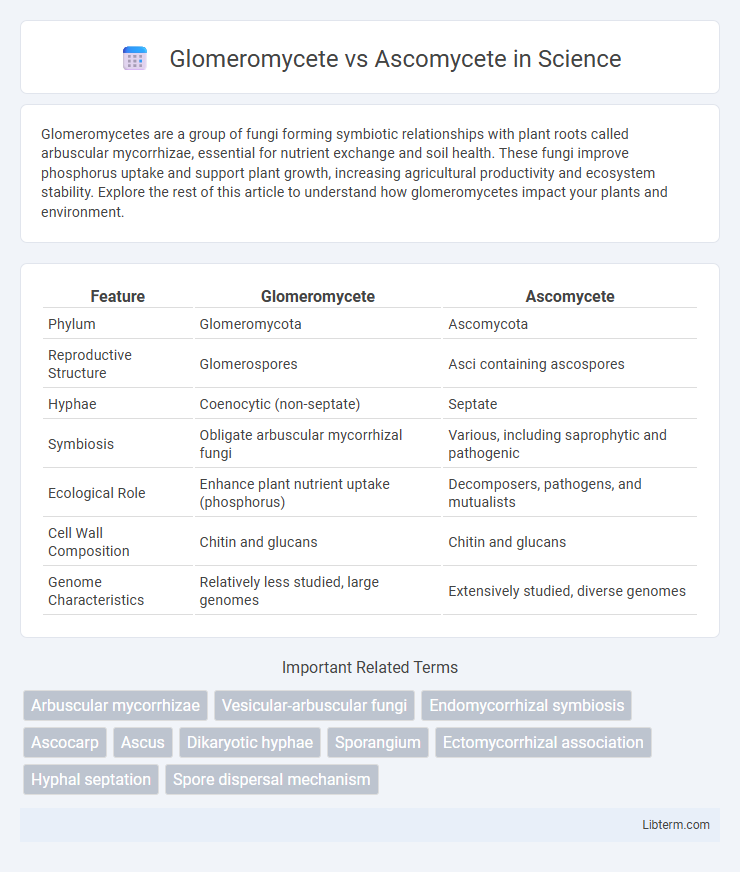Glomeromycetes are a group of fungi forming symbiotic relationships with plant roots called arbuscular mycorrhizae, essential for nutrient exchange and soil health. These fungi improve phosphorus uptake and support plant growth, increasing agricultural productivity and ecosystem stability. Explore the rest of this article to understand how glomeromycetes impact your plants and environment.
Table of Comparison
| Feature | Glomeromycete | Ascomycete |
|---|---|---|
| Phylum | Glomeromycota | Ascomycota |
| Reproductive Structure | Glomerospores | Asci containing ascospores |
| Hyphae | Coenocytic (non-septate) | Septate |
| Symbiosis | Obligate arbuscular mycorrhizal fungi | Various, including saprophytic and pathogenic |
| Ecological Role | Enhance plant nutrient uptake (phosphorus) | Decomposers, pathogens, and mutualists |
| Cell Wall Composition | Chitin and glucans | Chitin and glucans |
| Genome Characteristics | Relatively less studied, large genomes | Extensively studied, diverse genomes |
Introduction to Glomeromycetes and Ascomycetes
Glomeromycetes are a group of fungi primarily known for forming arbuscular mycorrhizal associations with plant roots, facilitating nutrient exchange and enhancing plant growth through symbiosis. Ascomycetes, the largest phylum of fungi, are characterized by their production of spores in specialized sac-like structures called asci, and include species ranging from yeasts to complex filamentous fungi. Both groups play crucial ecological roles, with Glomeromycetes dominating mutualistic plant relationships, while Ascomycetes encompass diverse lifestyles including decomposers, pathogens, and symbionts.
Taxonomic Classification and Phylogeny
Glomeromycetes belong to the phylum Glomeromycota, characterized by their obligate symbiotic relationships with plant roots forming arbuscular mycorrhizae, whereas Ascomycetes are classified under the phylum Ascomycota, known for their sac-like structure called asci that produce spores. Phylogenetically, Glomeromycota represent an ancient fungal lineage with limited species diversity, while Ascomycota encompass a highly diverse and evolutionarily advanced group exhibiting complex life cycles and extensive ecological roles. Molecular analyses of ribosomal RNA genes have reinforced the distinct evolutionary paths of these two groups, highlighting the deep divergence within the fungal kingdom.
Morphological Differences
Glomeromycetes exhibit coenocytic hyphae with large, multinucleate cells lacking septa, whereas Ascomycetes possess septate hyphae divided by cross-walls called septa. Glomeromycetes form arbuscular mycorrhizal structures within plant roots, characterized by vesicles and arbuscules, while Ascomycetes develop diverse fruiting bodies known as ascocarps containing sac-like asci with ascospores. The spore morphology also differs; Glomeromycete spores are typically large, thick-walled, and multinucleate, contrasting with the smaller, unicellular spores contained within asci in Ascomycetes.
Ecological Roles and Habitats
Glomeromycetes form arbuscular mycorrhizal associations with plant roots, significantly enhancing nutrient uptake, particularly phosphorus, in diverse terrestrial ecosystems ranging from grasslands to tropical forests. Ascomycetes exhibit vast ecological diversity, occupying roles as decomposers, pathogens, and symbionts across habitats like soil, aquatic environments, and plant surfaces. The symbiotic efficiency of Glomeromycetes is critical for plant health and soil fertility, whereas Ascomycetes contribute to nutrient cycling and ecosystem stability through organic matter decomposition and mutualistic interactions.
Reproductive Strategies
Glomeromycetes primarily reproduce asexually through the formation of large, multinucleate spores that enable efficient colonization of plant roots, lacking a known sexual reproduction stage. In contrast, Ascomycetes exhibit both sexual and asexual reproduction, producing sexual spores called ascospores within specialized sac-like structures called asci, and asexual spores known as conidia. This dual reproductive strategy in Ascomycetes facilitates genetic diversity and adaptability across diverse environments.
Symbiotic Relationships
Glomeromycetes form essential arbuscular mycorrhizal symbioses with over 80% of terrestrial plant species, facilitating nutrient exchange by enhancing phosphorus uptake. Ascomycetes, while diverse, primarily engage in symbioses such as lichens, where fungal partners provide protection and moisture retention to photosynthetic algae or cyanobacteria. These differing symbiotic roles highlight Glomeromycetes' critical contribution to plant nutrient cycles compared to the ecological niches occupied by Ascomycetes in mutualistic relationships.
Genetic and Genomic Features
Glomeromycetes exhibit a unique genetic composition with limited genomic data revealing their largely obligate symbiotic nature and reduced gene families associated with saprotrophic capabilities, contrasting sharply with Ascomycetes that possess expansive genomes enriched with diverse gene clusters related to secondary metabolism and complex life cycle regulation. Ascomycete genomes typically feature high gene density and well-characterized mating type loci, enabling intricate sexual reproduction, whereas Glomeromycete genomes show conservation of symbiosis-related genes like those involved in arbuscular mycorrhizal formation but lack homologs of many key biosynthetic pathways found in Ascomycetes. Comparative genomic studies demonstrate that Ascomycetes often contain extensive genomic plasticity facilitating adaptation to varied ecological niches, while Glomeromycetes maintain a streamlined genome optimized for obligate symbiosis with plant roots.
Economic and Agricultural Importance
Glomeromycetes form arbuscular mycorrhizal associations with over 80% of terrestrial plants, significantly enhancing nutrient uptake and soil fertility, which is crucial for sustainable agriculture and crop yield improvement. Ascomycetes include economically important species such as Penicillium for antibiotic production, Saccharomyces for baking and brewing, and numerous plant pathogens affecting major crops, impacting global food security and industry revenue. Both groups play essential roles in agriculture: Glomeromycetes by fostering plant growth and soil health, and Ascomycetes through their dual roles in biotechnology and plant disease management.
Contributions to Soil Health and Plant Growth
Glomeromycetes establish arbuscular mycorrhizal symbiosis with plant roots, significantly enhancing nutrient uptake, particularly phosphorus, and improving soil structure through hyphal networks that increase soil aggregation. Ascomycetes contribute to soil health by decomposing complex organic matter, recycling nutrients, and forming lichens that facilitate soil formation and stabilization. Both fungal groups play crucial yet distinct roles in promoting plant growth and maintaining sustainable soil ecosystems.
Key Differences Summarized
Glomeromycetes form arbuscular mycorrhizal relationships with plant roots and reproduce primarily through asexual spores, whereas Ascomycetes exhibit diverse reproductive strategies including sexual spores (ascospores) produced in sac-like asci. Glomeromycetes lack septa in their hyphae, resulting in coenocytic structures, while Ascomycetes have septate hyphae with cross-walls. Ecologically, Glomeromycetes play a vital role in nutrient exchange with plants, while Ascomycetes encompass a broad range of ecological roles from decomposers to pathogens.
Glomeromycete Infographic

 libterm.com
libterm.com